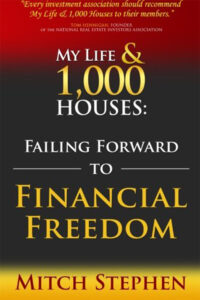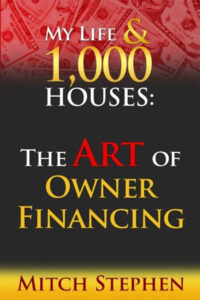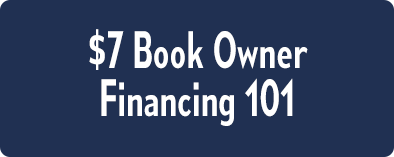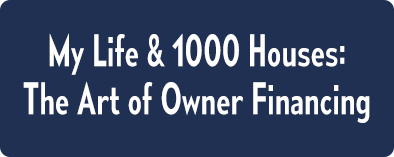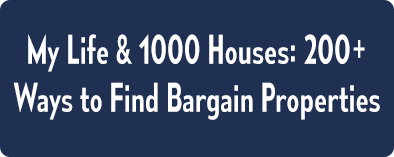PODCAST
The Secret To Selling Fast – Days On Market
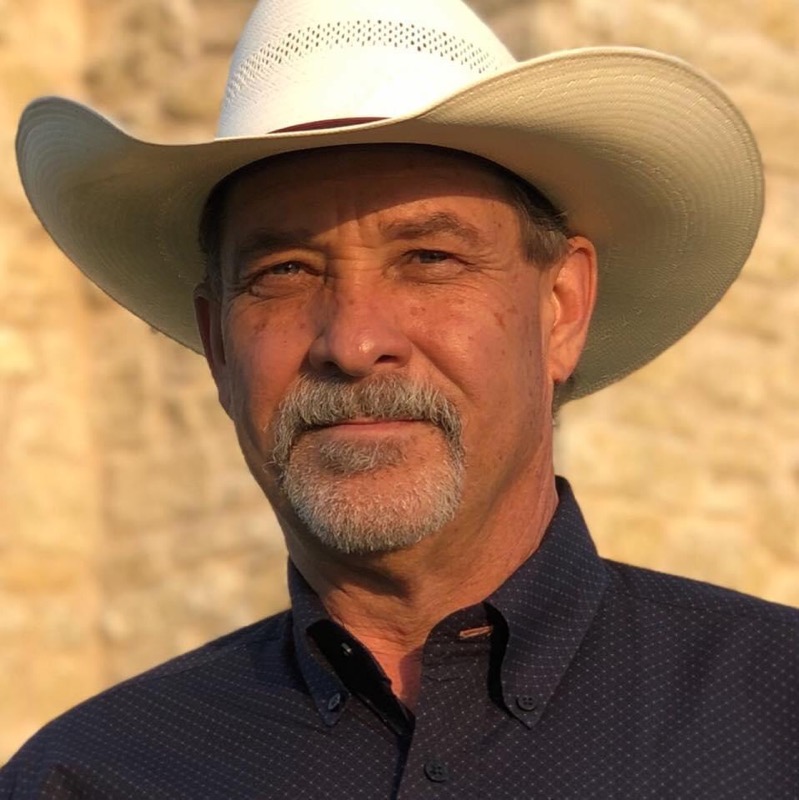

Mitch Stephen chats with
Mitch Stephen
Episode 551: The Secret To Selling Fast – Days On Market
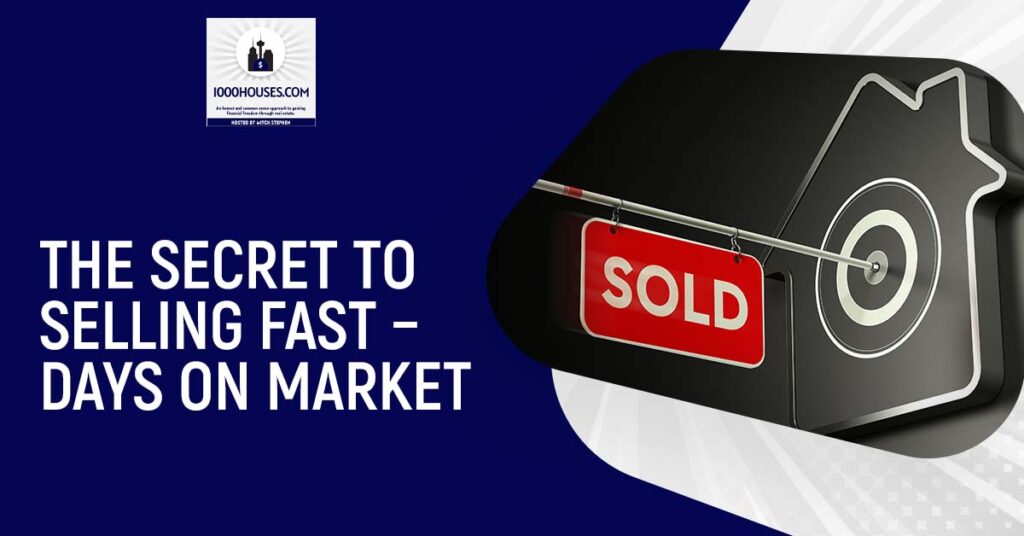
What’s the secret to selling fast? In this episode, Mitch explains how technology helped his real estate business. His problem with getting too many phone calls gave birth to LIVECOMM.com, and from there, things went well with his career. Proper utilization of technology paved his way to success. Want to know more? Tune in as Mitch spills secrets that will dramatically shorten your days on the market.
—
Watch the episode here
The Secret To Selling Fast – Days On Market
In this episode, I’m going to expose my plan of how I brought my days on market or my deal down to four days on average. That means when I put my houses up for sale, they are only up for sale for about four days until I get a contract. It takes a little longer to exactly close but that house is off the market and sold under contract within an average of four days. These are the last 200 houses that I’ve posted for sale. Remember, that’s an average. Sometimes, things will go on month but there are many houses I’ve sold before that we even had the paint dry. Not every house is gone in four days but it’s the average.
Let’s start with the problem that I had. I had to solve a very specific problem, which was the very beginning that started to lead me down a path to where I am. If I had known what the result was going to be or where the destination was, I could have gotten there much faster but I didn’t know. This all evolved so it took quite a while to get into the portrait and the picture that it looks like. That’s the whole point of this paid tutoring session or lesson plan on how to arrive at four days on market. It is for me to shortcut this for you. That’s what I’m going to do here.
The first inkling of the problem was when I was getting too many phone calls from my salespeople. That’s quite the problem to have. This is what I was doing and what was causing too many phone calls. I would have fifteen houses for sale with seller financing. The solution for our salesperson to sell the houses was to go out and put twenty bandit signs around the neighborhood where the house was advertising the house for sale. We’ll talk about what those signs look like in a minute but here’s the point. We have 15 houses with 20 signs around the neighborhood and 1 sign in the front yard. That’s 21 signs per house. That’s 315 bandit signs out.
People Calling Are Just Tire Kickers
We’re going to say it’s Friday. We’re going into the weekend. There are 315 signs out. My salesperson’s getting 150 to 250 phone calls over the weekend. That’s way too many calls. To top it off, a lot of those people calling are tire kickers. It’s just the neighbor across the street curious as to what the price is. They go and ask you all these questions and waste all your time. At the end of the conversation, they tell you, “I’m the neighbor. I’m not in the market for a house. I wanted to find out about the house and see what the houses in my neighborhood were going for.” It’s like, “I wasted fifteen minutes of my life I’ll never get back for nothing.”
Some people want the house and are serious but don’t have any down payment. No matter how much you emphasize, “It requires a 10% minimum down payment. This house requires at least $15,000 down or more,” it doesn’t matter. These people are still going to call and waste your time. My salesmen, by 11:30 AM or 12:00 PM on Saturday afternoon, quit answering the phone. They’re fried. Every time they hang it up, it’s ringing again. While they’re on the phone, it’s ringing. People are trying to break in. They got to go and listen to their messages. Their message box is filling up. People want to know about one of those houses. It was crazy.
My job was to try to figure out how to quell that situation. What I did was I invented LiveComm.com. What LiveComm.com was supposed to do for me was I could buy very cheap phone numbers. It costs about $2 a month. I got 15 houses for sale and $30 worth of phone numbers. That’s a big deal. These houses are worth a small fortune if I can get them sold for the price that I want or anywhere close.

Selling Fast: Anytime you go to an open house with a handful of people, especially when it’s a seller-financed home, someone always says, “What if we all want to buy the house? How are we going to decide who it goes to?”
I would get the fifteen phone numbers. These weren’t regular phone numbers. These were smartphone numbers. Smart phone numbers are the phone numbers that have a text distribution list attached to them. Every one of the LiveComm.com phone numbers has a text distribution list attached to it. Whenever someone calls your LiveComm phone number or my LiveComm phone number from their cell phone, the system captures the phone number and puts it into the text distribution list for later use by you and me. We can simply text everyone who has ever called us for $0.2 per recipient, which is nothing.
I started to have this system built. I had drawn the tree and what I wanted to do but the main thing I wanted it to do was for this smartphone number to be able to be forwarded to a recording. If we take the property information sheet that we developed, which is as long as my arm, the sheet has everything on it. It has what year the house was built, how many bedrooms and baths it has, how many square feet of land it is, what the measurements in length and width are and what school districts are there. Is the stove electric or gas? Is the water heater electric or gas? How old is the roof? Seven years? It has everything I can think of to tell you about a house.
Not only does it have the information pertaining exactly to the house but that recording also included information as to my offer to seller-finance it to prospective buyers out there. That means I was describing the sales price, the minimum down payment and the balance at 10% for 30 years. This would be the PITI payment plus the servicing fee. All of it added together was the total PITIS payment. What they would have to do if they wanted to own this house? What were the requirements? What would they have to give me? What were my expectations? What could they expect?
This is what happened. I made the recording. When I say I made the recording, I had the property information sheet, which had everything in the world on it. If you come up with something that I don’t have on that sheet that you think needs to be on there that some prospect asked you, call me and let me know. We’ll add it to the sheet. The whole point of that property information sheet is that there should be no more questions left to ask about this house. The idea is when a prospect calls, it’s all there. It’s delivered in its entirety and accurate.
Let’s say a caller calls one of my signs. The LiveComm smartphone number is forwarded to a recording. We’ve made the recording. The recording says, “Thanks for calling about the property at 123 Main Street.” You then start reading the sheet. It’s like, “That property is a 3-bedroom, 2-bath home with a 2-car garage. It has a lot that measures 150×50. It’s a total of 5,000 square feet.” You’re reading the property information sheet. In the end, I did something very different. You can look at it 1 of 2 ways but the cool thing was I was capturing the cell phone numbers of everyone who was listening to that recording. I was never going to miss anyone but I still didn’t give them our phone numbers.
At the end of the recording, it would say, “If you think that 123 Main Street is the property and the house for you and your family, then this is what you do. Get you and your family into the car. Drive to 123 Main Street, get out and look at the front yard. Walk around the side and go to the backyard. Look all around the house, look through the windows and check out the neighborhood. If you still think this is the house for you and your family and you have X amount or more for a down payment, then go call the green phone number in the back window.” That changes everything.
The whole point of that property information sheet is that there should be no more questions left to ask about the house. The idea is that when a prospect calls, it's delivered entirely and accurately. Share on XThose 150 to 250 calls that my salesman was having to endure, not only was he having to endure them but he wasn’t even accomplishing what I needed to get accomplished when he picked up the phone. They’re supposed to know everything about these houses but they don’t have everything memorized. They’re supposed to carry fifteen property information sheets with them at all times so they can flip through and get all the information accurate but they don’t. They’re answering the phone part-time. They’re giving partial information and even part of that information is incorrect.
The sales side of the equation wasn’t helping me at all. It was probably hurting me. I got these smartphone numbers. They’re capturing the cell phone of every incoming caller if they call from their cell phone, which is 99.99% of the people because they are calling off a bandit sign. Bandit signs are out in the field. People don’t carry around a landline on their back when they’re out in the field driving. They’re going to be calling from a cell phone. That collection system is going to blow your mind when I tell you where it went.
Here we got these salesmen. We’ve corrected the process. People call on the house and get a recording. This recording will answer at 6:00 AM on Sunday and 11:30 PM on Friday. It never not answers. It always answers. If you get the information correct when you fill out the property information sheet before you read it into the recording, then that message is delivered correctly every time too. All the information is accurate and timely. If you have a little pep in your voice and a smile on your face when you’re reading it, it sounds joyful every time no matter what time it is. If you make it professional, it is going to sound professional every time. If you get this recording right, then you’ve got a hell of a sales tool here.
We were starting to collect all these phone numbers. It was great. In the early stages, we would text everybody at 2:00 PM. Whenever we were going to have a showing for one person at 6:00 PM, we text everybody about 2:00 PM or 3:00 PM and say, “We’re going to be over at 123 Main Street at 6:00 PM. There’ll be an open house. If you want to come, come on over. I’ll be there with the lights on.” If you hit send, that’s $0.2 a person.
When you get there to show that 1 client the house at 6:00 PM, there are 10 or maybe 15 other people in the front yard waiting for you. This helps in the quality of buyers that you get and the amount of down payment that you get. The more down payment we get, the better. When we started, we had a 10% down payment as a minimum. That was the least we would take. As we progressed through and started getting more popular through some strategies that I’m in the process of telling you, those down payments went into under 15%. We average down payments a little less than 15% when we used to average 10%. That’s a good thing too.
What happens when there are 10 or 15 people in the front yard when you go to show 1 person in the house? That means there’s some competition for the house and a sense of urgency instilled in all the people that are there. They have a sense of, “I might need to come up with a little more down payment than I wanted to because I’m going to be competing with these other buyers.” I always make it known.

Selling Fast: The recording doesn’t matter what you say. All that matters is that you capture the cell phone number of the guy interested in the seller, finance home.
Anytime you go to an open house with a handful of people, especially when it’s a seller-financed home someone will go, “What if we all want to buy the house? How are you going to decide who it goes to?” That’s when I always reply, “The person I have to look at the hardest is the person with the most down payment but that doesn’t necessarily mean that’s the person I’m going to go with. There are other factors that I need to consider. I want to sell this house to 1 person at 1 time. I never want to see this house again. I’m not in the business of taking houses away from people or taking houses back. I’m in the business of selling houses.”
I’m going to look at a lot of criteria. What is your payment history like? What is your job like? How much disposable income do you have? I need to have at least a reason to believe that you can even make the payment. It doesn’t matter how much down payment you gave me. You still got to make the payments every month. I need to make sure that’s going to happen. I don’t want anyone to lose their down payment and the house. That’s my pitch on that.
If you change the price, you could send out a text to everyone who called on 123 Main Street. If you change the down payment, you could say, “I’ve decided to take a lesser down payment if you’ll take the house as is and fix it yourself.” You could send all that out. You could send a link with all the pictures of the house after it has been remodeled and the remodel is complete. You can do all kinds of things with a smartphone number and text messaging.
How often does a text message get listened to or viewed? It’s all the time. How many text messages have you ignored? The answer is probably zero. The national open rate is 96% plus. It seems a little low at 96%. Those other people don’t open their text messages because they’re dead or drunk. Who doesn’t look at their text messages?
Even if that 4% is true, a 96% open rate for $0.2 to a customer that has already called you and has already raised their hand and said they’re interested in your product is the most effective marketing ever in the world. For $0.2, you get to communicate with a 96% plus open rate to a customer that wants your product and has called you to let you know that they’re still interested in your product.
It’s a bullseye between the eyes for $0.2 a person. If you have 10,000 people on that list, that’s $200 to hit 2,000 interested customers. That’s ridiculously low. It’s the best value on advertising ever in the history of the world even if you want to include the cost of money for plastic signs. It becomes ridiculous however way you want to slice it.
When you show one person in the open house with 10 or 15 people, there's a sense of urgency instilled in everyone there. Share on XI had these salesmen that were overwhelmed. They were getting too many calls. They weren’t answering. They were delivering incomplete and incorrect information. My prospects are getting answered every single time. Every bit of information is so complete that it will make you giddy. It’s a very complete detailed description of the house, the price and the seller-finance terms being offered. It’s always correct.
My prospects are vetting themselves. The serious ones are doing what I told them to do at the end of the recording. They’re driving to the house. They get out and walk around. If they’re serious, they are calling the phone number in the back window. Why is the phone number in the back window? It’s the only place to hide the number. If I put it in the front window, everyone will be calling me. They won’t have heard the recording. That phone number in the back window has my salesman’s phone number on it. That’s a LiveComm phone number too. It’s a LiveComm phone number forwarded to his cell phone. Why is that? It’s mandatory. He has to do it like that.
If he was using his cell phone number with all the cards and buildings and he’s going to leave, all my customers or clients are going to be calling him even though he doesn’t work for me anymore. He’s either going to be in business for himself. He would probably be doing what he was doing but for himself. He’s stealing all my customers and making a profit off of them. It’s gone into a different field of business.
People are calling him and he’s saying, “I don’t care. I don’t work there anymore,” and hanging up. Either way, it’s tragic for me because I lost all my goodwill for the 2, 3, 4 or 5 years that he worked for me. All those customers have lost my phone number. If you use a LiveComm number for your salesperson or acquisition people, then when they quit, you can unforward the LiveComm phone number from their cell phone number and forward it to the new salesman or acquisition guy.
When I first originated the idea for LiveComm, all I wanted was for the smartphone numbers to go to a recording. They then told me I could capture the phone numbers and we could have all these features. I’m going to talk about the features that we have later because the features are a lot. I went to them and the developer said, “This is a good idea.” I said, “How good of an idea do you think it is?” He said, “It’s good.” I said, “Do you want to own half of it?” They said, “We’d love to own half of it but how would we do that?” I said, “Why don’t you build it for free and then own half of it?”
I was trying to go get a piece of software that would help my business run better and wouldn’t cost me an arm and leg. I looked at other companies out there that were doing similar things. They didn’t have it tailored how I wanted it. They were charging me $0.5, $0.6 or $0.10 per text and per minute for the recording. It shouldn’t cost near that much. I didn’t want to pay that price so I was looking into building it myself.

Selling Fast: What matters is that you captured the phone number, but you shouldn’t be driving them to Facebook, and you should set up an automatic hello response to anyone who calls any of these numbers.
The developer thought it was a cool idea and then they decided they would build it for free if they could own half of it. I said, “That’s great. If you build it for free and you’re going to own half of it, you’re going to have to do a little extra work and be able to have a subscription service. Make it so that it can take credit card payments. You’re going to have to build a little bit more because if you’re going to build it and it’s going to be worth anything, we have to have subscribers and make a business out of it. Otherwise, I’ll just use it for my company and make my money there.” They agreed to build out LiveComm.
They said, “Why would you do that?” I said, “I don’t know how to talk to you technology guys. Every time I want to build something with tech guys, I always end up wasting my money. I don’t know how to please you because I don’t know your language and what you’re doing. I can’t even look to see if you’re doing it right. You could be coding this thing all in the wrong direction and I wouldn’t have any way of knowing.
I figured if I’m giving you half of the product you’re building and you develop a crappy product, then you’ll own half of a crappy product. If you’ve developed a good product, you’ll own half of a good product. I’m going to assume that you’re going to want to own half of a great product so you’ll build a great product. That was my rationale. I got it built for free. I own half and the developer owns half. We’re friends and we offer it to the public.
Let’s talk about features and how to use LiveComm. These were some of the features that I built in that at the time, nobody else had. I still don’t know if they have them. Every phone number that you buy from LiveComm has a list of options or features. If you turn the feature on for that phone number, then it’s on for that phone number. One of those features is the Hello Button.
The Hello Button
If you turn the Hello Button on, it means any time an incoming caller calls that smartphone number, not only will their phone number be put in the text distribution list but they will also receive a text from you saying whatever it is you want to say to them. When you click on the Hello Button, you have to fill out the field with what texts you want to be sent to them. The minute they start listening to the recording, they’re going to get a text. It’s going to say whatever you type in this field.
Keep in mind that text messages are 240 characters or less. You got to keep it short and succinct. I use the Hello Button to convey a text message that had my Facebook business page. My hello message would say, “To see all of my inventory, please go to Facebook.com and search Casas Dueño a Dueño SA.” For those of you that are not big in Spanish, that is Homes Owner To Owner San Antonio. What I wanted to do was drive them over to my Facebook page.
Facebook police are going to do what they're going to do, so make sure that the picture for your home sales company is diverse and shows as many nationalities, creeds, and colors as possible. Share on XAlso, on my hello message, it said, “To see all of my inventory, go to Facebook.com and search Casas Dueño a Dueño SA. Be sure to follow us and like us so that you’ll get notified every time we post a new house into our inventory.” You got to tell people what you want them to do. I wanted them to go to Facebook and follow. I had to give them a reason why they wanted to follow. They’ll be notified every time we post a new inventory up there.
Does it work exactly that way? Sometimes and sometimes not but I need them to go over there and follow. We post a lot more than just inventories. We post when people sell their houses to us and when people buy our houses. We sometimes post a little bit of the remodel that’s going on in an address. We always have the buyers with the exaggerated key holding up their paperwork or physical key. You can also train your buyers on what to expect.
On your Facebook business page, amongst the pictures, you can have a little thing that says, “How to buy a house from Casas Dueño a Dueño SA.” There could be a video or a page with some bullet points that say, “You’ll be required to give $2,000 of your down payment upfront. It’s non-refundable. If you’re approved and it’s refundable, it’s minus $50 per credit report if you’re turned down.” You could do it however you want to do it. Tell them what is going to be required so that when your salesman asks them for $2,000 made out to Moat Management, LLC, they’ve already heard that on your business page. They’re not reluctant anymore. They’re expecting that.
Some of them will even have the check in their pocket already made out to Moat Management, LLC. They’ll go, “I got my $2,000. Here’s my folder with my check stubs and proof of income. This is a list of my liabilities and the payments that I have to make every month. This is what you asked for on your Facebook page.” It’s a great way to train your buyers and prospects and relieve them of the anxiety of having to give a stranger a check for $2,000.
There’s another feature called the Instant Call Connect Button. If you turn that button on for a phone number. Any time someone calls and they’re listening to your recording, you or your salesman or both of you will receive a text that would say, “Someone from this phone number is listening to the recording for,” and it’ll say whatever you’ve named that phone number. If you’ve named that phone number 123 Main Street, then it’ll say, “Somebody from this phone number is listening to the recording on 123 Main Street now.” It poses the question. Do you want to give them a few minutes to get through the recording and then call them? They are engaged with your house.
We usually use the Instant Call Connect Button when the house is moving slowly. We’re averaging four days on the market. Let’s say I got a house and it’s coming up on twenty days on the market. Something’s wrong. I need to call back these people that called about that house, went out to see that house or are listening to that recording. Sooner or later, you find out that the reason why the house isn’t moving is that the neighbor’s coming over and telling everybody that there was a suicide committed in the front living room or the back bedroom.
People, especially the Hispanic culture, can be a little superstitious. They won’t buy a house where there has been a suicide or even a natural death sometimes if they’re aware of it. We’re required by law in Texas to disclose if there was a violent crime or death committed on the property. For suicide or natural deaths, we are not required to disclose. Still, people are afraid of suicide. I talked to some people that were potentially out there looking at my house so I know what the problem is. I can go over and talk to the neighbor and praise him for watching over my house. I’ll let him know that when I sell the house, I’m going to be paying him $500 for keeping an eye on the place.
I have never said, “Would you quit telling people about useless crap that’s not going to bother anybody? Someone committed suicide in the house. It’s neither here nor there. That event is over. That house is still going to be lived in by someone. It’s not going to be haunted or anything. It’s just going to be a house.” Probably 70% of the houses in the world have had someone die in them. Certainly, the hospitals have and we go there all the time.”
The point is when a house is moving slow, the salesman is bored or you want to talk to your clients to see what is going on out there in the world and why this house is taking 20 days to move when normally it takes 4 days, you can turn that Instant Call Connect Button on. It also invites the caller to connect with the salesperson. Not only does it say, “Someone from this number is calling about the recording on 123 Main Street now,” it goes on to say, “If you would like to speak to a live representative, do not hang up and you will be connected to a live representative immediately.” If the caller hangs on and doesn’t hang up, he’s going to ring the salesman’s phone number. This is called instant call connect. Your salesman has a chance to connect with the caller and the caller has a chance to connect to the salesman.
There are a whole lot more features. I’m not here to sell LiveComm. The only reason I’m talking to you in the LiveComm terms in the first place is that’s what I use. I don’t know how to talk to you on any of the other platforms out there because I don’t know how much they cost. I’m cheaper than all of them. I have features that they didn’t use to have. I don’t know if they have them now or not but I developed these features for a reason. It’s what I needed to sell houses. I developed it specifically to sell houses.
Oddly enough, every business on the planet should want the cell phone number of their customers and be able to text them. For example, pool companies. Put out a billboard that says, “Here are the top five things you need to consider before you commit to a pool company. There’s a free recorded message.” They will call that billboard. Put that on a billboard with a phone number that says, “Free recording.” People are likely to call for free recordings. Do you know why? They deem them as non-confrontational. They’re not going to be talking to a live person. No one’s going to confront them. Little do they know it’s not confrontational while they’re on the recording but they’re going to get confronted by me or my people soon enough depending on the circumstance.
My point is any business in the world could use LiveComm if they’re selling anything or they have a service. There are ways to use it. Do you want to know how to use it for a different business? Send a text message to Support@LiveComm.com and get ahold of me or ask a question. You could be like, “I have a carpet cleaning service. How can I use it? I have a pest control service. How can I use LiveComm to up my business? I sell pools or lawnmower equipment.” There’s a way to use LiveComm to increase your business.
Pay the seller a little better than everybody else if you want your stuff to move or be seen first. Share on XLet’s talk about Facebook in setting up the Facebook business page. I can’t go through it with a fine-tooth comb with you because no matter what I do, the Facebook police are going to do what they’re going to do. It’s not all that challenging since I’m warning you but make sure that the picture for your home sales company is diverse. It should show as many nationalities, creeds and colors as possible. If you put one White family up there standing in front of a house, they’re not going to let your page open because you’re showing some kind of bias. Make sure it’s maybe a collage of pictures where there’s a Hispanic couple over here, an older couple over here, a Black couple over here, an Asian couple here or a mixed couple.
Setting Up The Facebook Business Page
Keep answering the objections by the Facebook police until you get your page up. Use your hello message for each phone number to drive people over to the Facebook market page. Once you get about 3,000 people in your list, either the text distribution list or people following your Facebook page, those are pretty serious people. They’re not following you because they want to be nice. They’re following you because they want a home with seller financing. They’re checking in on it. Hopefully, they followed you so that they’re getting notices now and then when you post.
When you get to about 3,000 people, you’ll have about 10 to 15 days on the market. When you get about 6,000 followers, it’ll drop to less than 10. I’m at four. It’s unbelievable. It was at 9 and then COVID hit and it went to 4. I don’t know if that coincided with my amount of followers being at 3,000. COVID hit and then I was up to 6,000 because people didn’t have anything to do but to get on a computer. I’m not sure exactly what COVID had to do with it but when COVID hit, my days on market dropped. It could be a coincidence. It could be that about the time COVID hit, my numbers went up.
You can put these numbers all around the neighborhood for these signs. In my example, I had fifteen houses. I had fifteen phone numbers. I had 15 sets of 21 signs in different areas. Whenever I sell 123 Main Street, I assign that phone number to a different house. I got to change the recording to fit the new house that I’m assigning it to. I don’t take the phone numbers out or delete the phone numbers.
I don’t care what owner-financed house someone called about. I cared that I captured their phone number. I don’t care which house they called about. In LiveComm, I could text the people that called for this phone number or put a checkmark on every phone number and send out a text to all 10,000 people that ever called one of my phone numbers.
When you get to 6,000, 7,000, 8,000, 9,000 or 10,000 followers, you don’t even have to put any signs out for your houses. When you’ve got 7,000, 8,000 9,000 or 10,000 people following you on this seller finance page, Casas Dueño a Dueño SA, you don’t even have to put any signs up. Not even one. We don’t even put signs out because we don’t have to.
If you want to jumpstart your list of owner-financed buyers’ phone numbers, then you can also put out generic signs. Pick a phone number and assign it to a generic free list of owner-financed homes. You can name it Bandit Sign Owner-Financed Homes. You can put that generic sign out all over town that says, “Free list of owner-financed homes. Free recording and a LiveComm phone number.” In the recording, it doesn’t matter what you say. All that matters is that you capture the cell phone number of the guy who’s interested in the seller finance home. That’s all that matters.
Maybe your recording says something like, “You’ve called this phone number so you’ve been put on a text distribution list. Any time we have an owner-financed home becomes available, you’ll be sent a text message to go like and follow our page on Facebook. Go to Facebook.com and search Casas Dueño a Dueño SA or check your text messages. You’ve probably already received the texts telling you to go to Facebook and search Casas Dueño a Dueño SA. The reason why we sent it to you in a text is so you don’t have to remember it or write it down. You already have it on your phone when you hang up. Good luck. We hope you find your owner-financed home with us soon. Goodbye.”
Remember, calls cost $0.2 a minute and text messages cost $0.2 per recipient. You would want to edit down your recordings to be as efficient as possible. Why say something in 10 minutes if you can say it in 3 minutes? It’s costing you $0.2 a minute. If you have 100 people call about your house 123 Main Street and the recording is 10 minutes or 7 minutes, who cares? It’s not worth worrying about because when you sell that house, you’re going to make $15,000, $20,000, $25,000, $30,000, $40,000, $50,000 or more. That’s all chump change.
We pay our sales person 3% of the sales price like realtors. We do that on purpose because sometimes, we get realtors that want to sell our house. We figured if we made the commission 3%, then we could play both sides of the fence. We listed ourselves. My partner has access to MLS. He’s a broker. There are other ways to get access to MLS if you’re not a broker. You can put up flat fee listings where you only pay $200 or $300 to list the property and then pay the one who sells the house a 3%. You could maybe give them a bonus of 4%. Pay them a little bit better than everybody else if you want your stuff to move or be seen first. That’s why we made it 3% because sometimes, we go with the realtors.
Here’s the cool thing about a seller-financed home. You can always add 3% on top of whatever you think the value is because we don’t need an appraisal for me to seller finance your house. I’m the guy giving the loan. I’m the underwriter. If you and I can agree on a down payment and the payments for my house, then we’ll go to closing. I pay 3%. I only pay when the deal is final. I’m paying myself with money that’s already been brought to the table. I’m paying it out of the down payment and the closing costs.
On a $100,000 house, we’re averaging about 15% or a little less than $15,000. Our people have to come with closing costs, which are usually about $2,500. If we do the rent formula and establish an owner-financed value through the rent formula, let’s say that value is $112,000, I might go ahead and make it $115,000 and add $2,000 or $3,000 to cover my salesman’s commission or realtor’s commission. We don’t have to have appraisals. As long as that $3,000 doesn’t deter someone from buying the house, we don’t have to worry about appraisals or anything like that.
When you start, it takes a bit of time to shorten your days on the market and get it down there to something that's impressively done. Share on XIf the realtor is putting it on MLS, I figure out what their 3% is costing me and add it to the amount of down payment that they need to bring me. If I’m used to getting 10% down and the realtor says, “This realtor wants to sell my house,” I’ll say, “That’s great. You don’t need to get 10% down. You need to get at least 15% down.” They’re only asking for 3% so I could say, “You need to get 13% down.” That’d be my 10% plus his 3%. I could tell him his sales price is $3,000 higher than what I have out there but he needs to put it in MLS at enough to cover his commission.
Make them earn their commission. They want to charge $4,000 to sell your house and then add that $4,000 onto your owner-financed home. That doesn’t work in traditional homes where you’re asking what the appraisal is and you can’t go over the appraisal. If the appraisal’s $115,000 and your realtor is going to charge you $6,000 to sell the house, you can’t add $6,000 on top of $115,000 because the appraisal is only coming in at $115,000. In seller-financed houses, you can do that.
Let’s have a quick overview to shorten your days on market and get it down there to something impressive on 15 days or less. I’m down to four days. I got it down to signs and I’m a long way down the road. When you start, it takes a little time to get this done. Step number one, get with a phone service that has a lot of features that we need. I’m suggesting LiveComm. That’s the only one I know to talk to you about. That’s LiveComm.com. Buy some phone numbers, assign them to some properties you have for sale, make a recording and put out your twenty signs around the neighborhood and the one in the front yard.
If you’re getting beat up with phone calls, you may want to make those buyers vet themselves by not being able to contact anybody unless they call the phone number in the back window, which is generally the sales person’s direct phone number. If you do that, you have about 3,000 phone numbers. If you want to amp up the number of phone calls coming, go out and put out 200, 300, 400 or 500 bandit signs that say, “Free list of owner-financed homes. Free recorded message.” Then, put your LiveComm smartphone number there. Everyone will be calling for a free list of owner-financed homes. That means they’re the exact customers that you want. It doesn’t matter what you say on that recording. What matters is you captured the phone number.
You should set up an automatic hello response to anyone who calls any of these numbers. It should be driving them to your Facebook business page. Once you’ve driven enough people over to your Facebook business page, you will not need to use signs anymore. How much is enough? 3,000. You’re doing well but that’s not enough to stop putting out signs. You got to keep putting out signs until you get to about 6,000, 7, 000 or 8,000 people. You have to judge the caliber.
At around 6,000 people, you’ll start selling your house in under 10 days. Those are the people following you on your Facebook business page. The faster you put out signs, the more your list will grow. The faster your list will grow, the sooner you won’t have to put out signs. That concludes my little dissertation here on how I got down to four days on the market using technology, some plastic signs and Facebook.
Be sure to check out my book, Failing Forward to Financial Freedom. This is a story. It’s not deep into the how-to but you could learn a lot from this, especially if you’re a young entrepreneur getting ready to go out there and kick around a little bit. This was my whole thought process through that falling, getting back up over and over again and how to keep morphing. It’s how I used my head, my brain and the thought processes I went through to be able to buy a house every 4 to 5 days for over 2.5 decades. That’s about 100 houses a year for over 25 years. This book depicts how the guy figured out how to get that done.
The second book is My Life & 1000 Houses: 200+ Ways to Find Bargain Properties. This will get your mind going. This was pre-LiveComm. However, there is a lot of good stuff in here. I’ve used LiveComm to do a few things for purchasing but this book is about a whole different effort. It’s about thinking outside the box and looking in places where the average person is not going to look for a bargained property.
Last but not least is My Life & 1000 Houses: The Art of Owner Financing. This is the end of a three-book series. This book is worth $1 million. I usually charge about $50 for it at 1000Houses.com. Some people go, “Why is that book so expensive?” I have to tell them, “I want you to put the book down and step away from it. You’re not ready.” This book is worth $1 million to anybody who wants to implement what’s in here. It could be worth $1 million to you. It has been worth millions to me. I got out there and laid it all out on the line for you.
I also have a book called The Art of Private Lending. This is how I raise private money and talk to people about loaning me money, what’s behind their money, the paperwork, collateral and how private lending works. If you want to learn how to lend money, this is a great place to go. If you want to lend the money but don’t want to have a job, then maybe you can lend money directly to me or someone like me. We’ll do everything that is required in this book to protect everyone. You can keep playing golf and we’ll send you a principal and interest check every month. Check it out.
I also wrote a book that was not about real estate. I quit drinking and smoking on the same day on August 1st, 2019. I didn’t use a doctor, a therapist, a patch, a pill or anything. This was my thought process about how I planned, prepared and got through it. If you are a heavy drinker, it could be very dangerous to quit cold turkey without a doctor’s supervision. Why I didn’t have complications from quitting smoking and drinking, I don’t know. I have since learned that a lot of people can have some pretty severe complications if they quit alcohol cold turkey. I know of some people that have died from it so be very careful about that.
This is a book called ENOUGH! It’s about how I quit drinking and smoking and lost about 65 pounds. It’s off the topic of real estate but the only reason I bring it up is it has gotten so much popularity. It has drawn so much attention that I feel like there’s a segment of people out there, especially us entrepreneurs that are Triple-A, always on the go, hard-charging, ADD and crazy business guys that there’s a problem with abuse and addiction.
I’m giving that book away. If you want to go to 1000Houses.com/ENOUGH, you can get the digital book free. It’s more of community service. I’m not in that for the money with that book or topic. If you want a physical book in your hand, you can order on Amazon or at my website, 1000Houses.com. The digital book can be delivered to you for free if you go to 1000Houses.com/ENOUGH.
I hope that you enjoyed this episode. If you’re interested at all in weekly communication with a pro run past them with what you’re doing, what you’re thinking, how you might approach a situation, how you could up your game and how you can stay out of trouble or all kinds of things, we have a call every Tuesday at 7:00 PM Central Standard Time. Check it out. There’s a free archived recording at 1000Houses.com underneath Free Stuff. Listen to that recording of how one of those Tuesday night calls go.
There are usually 15 to 40 people on the call. The commitment on that call is that we’re going to answer every single question. It usually lasts about 45 minutes to 1 hour and 15 minutes. Our commitment to answer every question will be begging for mercy for around two hours. If someone needs their question answered, then leave your hand up and we will get to you no matter how long it takes. I’ve been on that call a few times for over three hours. We were having fun. Check out the Tuesday night call.
If you’re in this business and you don’t have a coach that is an expert in the strategy that you’re trying to work on, then you’re making a big mistake, whether the coach is me or someone else. Take me off the table for a second. You got to have a coach. You’re either going to pay the street in mistakes and bad choices that a coach never would’ve let you do or you’re going to pay a coach. The coach is probably going to be the cheapest option. You won’t know it because you won’t know how much money you lost, could have stayed out of this trouble or not gotten into this lawsuit.
A coach is probably going to be the cheapest way. It’s the path of least anxiety. You have someone to talk to once a month and ask what they’re doing. I know sentences that can up your game more than that call costs. If you’re interested in the weekly Q&A call or the group coaching call, then email Support@1000Houses.com and say, “I’m interested in more information for the group coaching or the Tuesday night call. Someone talk to me, please.” We’ll get it over to you. You can also go listen or read about it on my website at 1000Houses.com. I appreciate you taking the time and honing up your house-selling skills. I hope I’ve been an asset to you. I’m out of here.
Important Links
- 1000Houses.com/Coaching
- 1000Houses.com/LiveComm
- 1000Houses.com/TFF
- 1000Houses.com/VAHelp
- 1000Houses.com/AOF
About Mitch Stephen
 Mitch Stephen has purchased a property in or about San Antonio Texas every 4-5 days…for over 2 decades. Approximately 100 houses per year and well over 2,000 properties. His real estate investing career started at the age of 23 when he read “Nothing Down” by Robert Allen. A high school graduate, who never stopped learning. Books, CDs, seminars and webinars were his classroom. He has perfected a method of achieving cash flow without having to be a landlord and without having to rehab properties. He’s mastered the art of raising private money and the classic “Nothing Down” deal. A passionate speaker who delivers a message of integrity first and profits second; an expert at keeping it simple and explaining, in plain English, the theories that made him financially independent. He is always an inspiration to those around him.
Mitch Stephen has purchased a property in or about San Antonio Texas every 4-5 days…for over 2 decades. Approximately 100 houses per year and well over 2,000 properties. His real estate investing career started at the age of 23 when he read “Nothing Down” by Robert Allen. A high school graduate, who never stopped learning. Books, CDs, seminars and webinars were his classroom. He has perfected a method of achieving cash flow without having to be a landlord and without having to rehab properties. He’s mastered the art of raising private money and the classic “Nothing Down” deal. A passionate speaker who delivers a message of integrity first and profits second; an expert at keeping it simple and explaining, in plain English, the theories that made him financially independent. He is always an inspiration to those around him.
Mitch, together with his wife, Tommi, and his daughter, Shannon purchased their fair share of local houses. Their company, Independence Day, Inc., has bought and sold over 2,000 properties in and about San Antonio, Texas since 1996. This company specializes in buying distressed properties with OPM and selling those properties with Owner Financing.
The Stephen family built wealth by purchasing very affordable homes, selling them for double the cost, and the owner financing the sale by creating a note to their buyer. In 1991 the family made plans to keep their wealth and create “Forever Money” by acquiring SelfStorage and Boat Storage facilities primarily around Canyon Lake where they live in Texas. They started with 13 boat storages around the lake, and the storage business has grown to over 1300 storage doors.
Mitch offers Online Education, Group Coaching, and Full-on Mentorships as it relates to all the aspects of Owner Financing. Mitch’s personal expertise includes; Raising Private Money, Finding Bargain Properties, Negotiating Favorable Terms, Dealing with Renovations and Contractors, Selling Houses, Selling Notes with little to NO Discount, and helping others deal with the everyday throws of life in business. He is very familiar with Dodd-Frank, RMLOs, S.A.F.E. Act, Texas Property Code, Truth -in-Lending, R.E.S.P.A. and the legal options available in the owner finance domain.
Love the show? Subscribe, rate, review, and share!
Join the Real Estate Investor Summit Community:
- reinvestorsummit.com
- Real Estate Investor Summit Facebook
- Real Estate Investor Summit Twitter
- Real Estate Investor Summit YouTube
- Mitch Stephen LinkedIn

